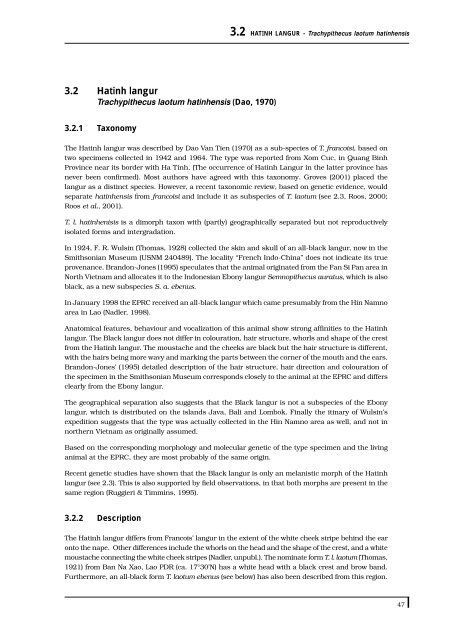Vietnam Primate Conservation Status Review 2002 - Hoang Lien ...
Vietnam Primate Conservation Status Review 2002 - Hoang Lien ...
Vietnam Primate Conservation Status Review 2002 - Hoang Lien ...
Create successful ePaper yourself
Turn your PDF publications into a flip-book with our unique Google optimized e-Paper software.
3.2 Hatinh langur<br />
Trachypithecus laotum hatinhensis (Dao, 1970)<br />
3.2.1 Taxonomy<br />
3.2 HATINH LANGUR - Trachypithecus laotum hatinhensis<br />
The Hatinh langur was described by Dao Van Tien (1970) as a sub-species of T. francoisi, based on<br />
two specimens collected in 1942 and 1964. The type was reported from Xom Cuc, in Quang Binh<br />
Province near its border with Ha Tinh. (The occurrence of Hatinh Langur in the latter province has<br />
never been confirmed). Most authors have agreed with this taxonomy. Groves (2001) placed the<br />
langur as a distinct species. However, a recent taxonomic review, based on genetic evidence, would<br />
separate hatinhensis from francoisi and include it as subspecies of T. laotum (see 2.3, Roos, 2000;<br />
Roos et al., 2001).<br />
T. l. hatinhenisis is a dimorph taxon with (partly) geographically separated but not reproductively<br />
isolated forms and intergradation.<br />
In 1924, F. R. Wulsin (Thomas, 1928) collected the skin and skull of an all-black langur, now in the<br />
Smithsonian Museum (USNM 240489). The locality “French Indo-China” does not indicate its true<br />
provenance. Brandon-Jones (1995) speculates that the animal originated from the Fan Si Pan area in<br />
North <strong>Vietnam</strong> and allocates it to the Indonesian Ebony langur Semnopithecus auratus, which is also<br />
black, as a new subspecies S. a. ebenus.<br />
In January 1998 the EPRC received an all-black langur which came presumably from the Hin Namno<br />
area in Lao (Nadler, 1998).<br />
Anatomical features, behaviour and vocalization of this animal show strong affinities to the Hatinh<br />
langur. The Black langur does not differ in colouration, hair structure, whorls and shape of the crest<br />
from the Hatinh langur. The moustache and the cheeks are black but the hair structure is different,<br />
with the hairs being more wavy and marking the parts between the corner of the mouth and the ears.<br />
Brandon-Jones’ (1995) detailed description of the hair structure, hair direction and colouration of<br />
the specimen in the Smithsonian Museum corresponds closely to the animal at the EPRC and differs<br />
clearly from the Ebony langur.<br />
The geographical separation also suggests that the Black langur is not a subspecies of the Ebony<br />
langur, which is distributed on the islands Java, Bali and Lombok. Finally the itinary of Wulsin’s<br />
expedition suggests that the type was actually collected in the Hin Namno area as well, and not in<br />
northern <strong>Vietnam</strong> as originally assumed.<br />
Based on the corresponding morphology and molecular genetic of the type specimen and the living<br />
animal at the EPRC, they are most probably of the same origin.<br />
Recent genetic studies have shown that the Black langur is only an melanistic morph of the Hatinh<br />
langur (see 2.3). This is also supported by field observations, in that both morphs are present in the<br />
same region (Ruggieri & Timmins, 1995).<br />
3.2.2 Description<br />
The Hatinh langur differs from Francois’ langur in the extent of the white cheek stripe behind the ear<br />
onto the nape. Other differences include the whorls on the head and the shape of the crest, and a white<br />
moustache connecting the white cheek stripes (Nadler, unpubl.). The nominate form T. l. laotum (Thomas,<br />
1921) from Ban Na Xao, Lao PDR (ca. 17°30’N) has a white head with a black crest and brow band.<br />
Furthermore, an all-black form T. laotum ebenus (see below) has also been described from this region.<br />
47



